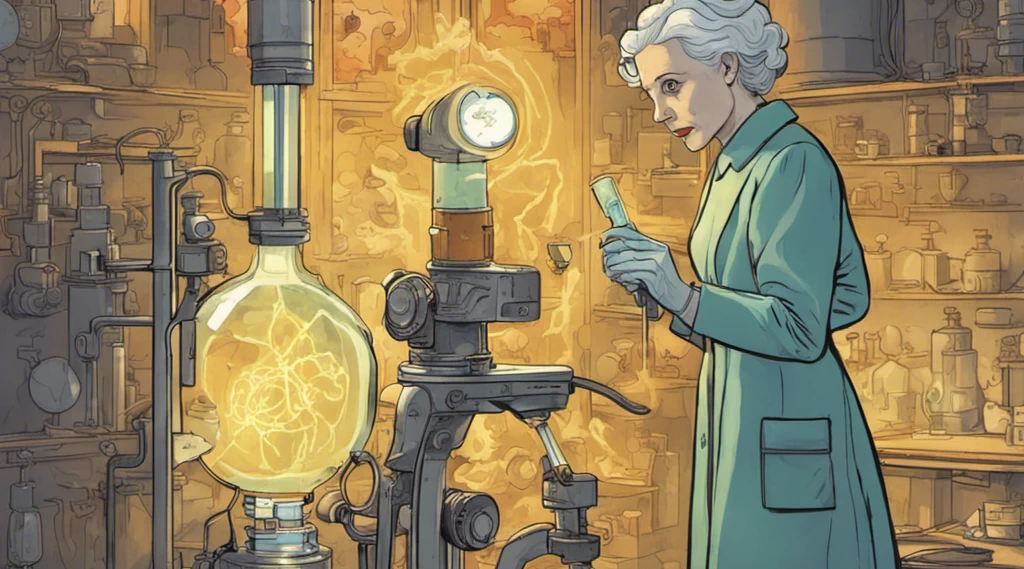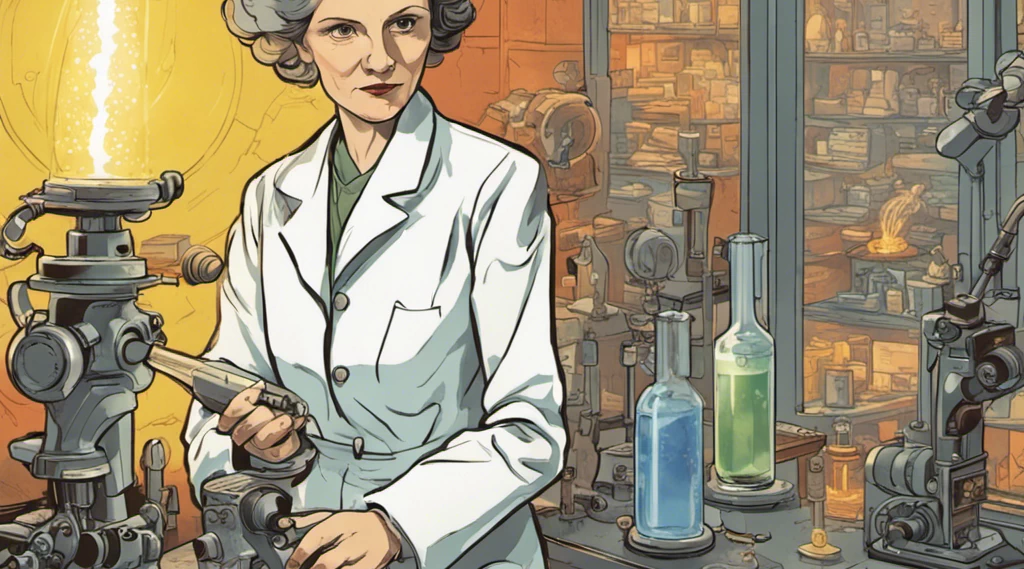Madame Curie: A Trailblazer in Science
"Madame Curie" is a biography that explores the life and scientific achievements of Marie Curie, the pioneering physicist and chemist who made groundbreaking contributions to the fields of radioactivity and X-rays.
Chapter 1 What’s Madame Curie about
"Madame Curie" is a biography written by Ève Curie, the daughter of Marie Curie and Pierre Curie. The book details the life and achievements of Marie Curie, a pioneering scientist who made significant contributions to the field of radioactivity.
Ève Curie's biography provides a comprehensive account of Marie Curie's personal and professional journey. It explores her early life in Poland, her move to France to pursue higher education, and her groundbreaking research on radioactivity alongside her husband, Pierre Curie. Their collaboration led to the discovery of two new elements, polonium and radium, and earned them the Nobel Prize in Physics in 1903.
The book also delves into the challenges Marie Curie faced as a woman in the male-dominated scientific community of the time. It discusses her persistence and determination in overcoming societal barriers and pursuing her scientific passions.
Furthermore, "Madame Curie" examines Marie Curie's later years after the tragic death of Pierre Curie and her subsequent work to establish radium institutes. It sheds light on her dedication to furthering scientific knowledge and her contributions to medical advancements through the use of radioactive materials.
Overall, Ève Curie's biography offers a compelling and intimate portrayal of Marie Curie as a brilliant scientist, a devoted wife and mother, and a trailblazer for women in science.
Chapter 2 Why is Madame Curie Valued
Madame Curie, also known as Marie Curie, is highly valued and recognized for several reasons:
- Groundbreaking scientific contributions: Madame Curie made groundbreaking discoveries in the field of radioactivity. Alongside her husband Pierre Curie, she discovered two new elements, polonium and radium, and coined the term "radioactivity" to describe the phenomenon. Her research laid the foundation for modern physics and chemistry, revolutionizing our understanding of atomic structure and paving the way for nuclear physics.
- Nobel Prizes: Marie Curie was the first woman to win a Nobel Prize and remains the only person to have received Nobel Prizes in two different scientific fields. She won the Nobel Prize in Physics in 1903 along with her husband Pierre and Antoine Henri Becquerel, and later received the Nobel Prize in Chemistry in 1911 for her discovery of radium and polonium. These achievements highlight her exceptional scientific prowess and the impact of her work.
- Trailblazing role for women in science: As a woman in a male-dominated field during the early 20th century, Marie Curie faced numerous challenges and prejudices. Despite this, she persevered and became an inspiration to countless women pursuing science, challenging societal norms and breaking barriers. Her accomplishments opened doors for women in academia and helped pave the way for future generations of female scientists.
- Dedication and resilience: Marie Curie's dedication to her work was unparalleled. She spent countless hours conducting experiments and faced numerous obstacles, including limited resources and health risks due to radiation exposure. Her commitment and perseverance in the face of adversity serve as a testament to her passion and determination.
- Humanitarian efforts: During World War I, Marie Curie applied her scientific knowledge to help treat wounded soldiers. She developed mobile radiography units, which came to be known as "petites Curies," to provide X-ray services to military hospitals. Her contributions in this field saved countless lives and showcased her selflessness and concern for others.
In summary, Madame Curie is valued for her groundbreaking scientific achievements, her role as a trailblazer for women in science, her dedication and resilience, and her humanitarian efforts. Her work continues to impact various scientific disciplines, inspire generations of scientists, and shape our understanding of the natural world.
Chapter 3 Summary of Madame Curie
This article delves into the extraordinary life and achievements of Madame Curie, a woman who revolutionized the fields of physics and chemistry. From her early struggles as a Polish immigrant to becoming the first female Nobel laureate, Marie Curie's journey is nothing short of remarkable. Her groundbreaking discoveries, including the isolation of radium and polonium, paved the way for modern scientific advancements and solidified her status as an icon in the scientific community. Beyond her scientific contributions, Madame Curie's unwavering determination and commitment to humanitarian efforts make her an inspiration for generations to come.
Chapter 4 Madame Curie’s Author
The book "Madame Curie" is a biography written by the author Eve Curie. Eve Curie was the daughter of Marie Curie, the renowned physicist and chemist who made groundbreaking discoveries in the field of radioactivity.
Eve Curie released "Madame Curie" in 1937. The book provides an intimate portrait of her mother's life and work, chronicling Marie Curie's scientific achievements, as well as her personal struggles and determination.
Apart from "Madame Curie," Eve Curie also wrote other books during her career. One of her notable works is "Journey Among Warriors," published in 1943. This book recounts Eve Curie's experiences working as a war correspondent during World War II. It explores her encounters with soldiers and civilians, providing a unique perspective on the wartime events.
Regarding the best edition of these books, it is subjective and depends on individual preferences. However, "Madame Curie" has seen multiple editions over the years, including various translations into different languages. The latest edition of the book may offer additional content or updated information. When looking for the best edition, it is advisable to consider recent releases or special editions that provide supplementary material or annotations.
Chapter 5 Madame Curie Meaning & Theme
1. The Madame Curie Meaning
Madame Curie refers to Marie Skłodowska-Curie, a renowned scientist who made significant contributions to the field of radioactivity and was the first woman to win a Nobel Prize. "Madame" is a title of respect given to married women in French.
The meaning behind Madame Curie lies in the extraordinary life and achievements of Marie Curie herself. She revolutionized our understanding of physics and chemistry, discovering two radioactive elements, polonium and radium. Curie's groundbreaking research laid the foundation for the development of nuclear physics and led to innovations such as radiation therapy for cancer treatment.
Beyond her scientific accomplishments, Madame Curie also represents determination, resilience, and breaking barriers. As a woman in a male-dominated field, she faced numerous challenges but persevered, overcoming societal obstacles and achieving remarkable success.
Marie Curie's work and legacy serve as an inspiration to generations of scientists, particularly women, highlighting the importance of pursuing one's passion, challenging traditional norms, and making valuable contributions to society through scientific exploration.
2. The Madame Curie Theme
The theme of the book "Madame Curie" by Ève Curie revolves around the extraordinary life and achievements of her mother, Marie Curie. The book explores several key themes that illuminate Marie Curie's dedication to scientific discovery, her struggles as a woman in a male-dominated field, and her unwavering determination in pursuit of knowledge.
- Scientific Discovery: The book highlights Marie Curie's groundbreaking research on radioactivity and her subsequent discoveries of the elements polonium and radium. It emphasizes her relentless pursuit of scientific knowledge and her commitment to advancing the field of physics through her experiments and theories.
- Gender Equality: Another important theme in the book is Marie Curie's struggle against gender discrimination in the scientific community. Despite facing numerous obstacles and prejudice due to her gender, Marie Curie fought for recognition and equal opportunities. The book portrays her as a trailblazer who defied societal norms and paved the way for future generations of female scientists.
- Sacrifice and Perseverance: "Madame Curie" also explores the personal sacrifices Marie Curie made in her quest for scientific advancement. The book delves into her tireless work ethic, her dedication to her research, and the toll it took on her personal life. It reveals the challenges she faced as a widowed mother raising two daughters while juggling her scientific career.
- Legacy and Inspiration: The theme of legacy runs throughout the book, highlighting Marie Curie's lasting impact on science and society as a whole. Her accomplishments continue to inspire scientists and women worldwide, serving as a testament to the power of perseverance and intellectual curiosity.
Overall, "Madame Curie" celebrates Marie Curie's remarkable contributions to science, her resilience in the face of adversity, and her lasting influence as a role model for future generations.
Chapter 6 Tapping Into Digital Sources to Learn about Madame Curie
If you're interested in exploring various formats and concise summaries of the book "Madame Curie", we suggest checking out platforms like Bookey, where you can find a diverse collection of books available in different formats, accompanied by brief summaries that offer a quick glimpse into the book's content. This is particularly helpful for individuals seeking a comprehensive overview without investing excessive time. For those looking to gain visual insights about the book, YouTube is an excellent resource with a plethora of videos dedicated to "Madame Curie". You'll find videos like "Marie Curie - Talk" that provide a more detailed and informative analysis of the book. Unfortunately, we are unable to provide a PDF version of "Madame Curie" here, as our main objective is to introduce you to the value of reading this book and present additional reading options. Enjoy your reading journey!
Chapter 7 Quotes about Madame Curie
Madame Curie, a remarkable scientist and the first woman to win a Nobel Prize, left behind numerous inspiring quotes that reflect her passion for science and the pursuit of knowledge. Here are some notable Madame Curie quotes:
- "Nothing in life is to be feared, it is only to be understood. Now is the time to understand more so that we may fear less."
- "Have no fear of perfection - you'll never reach it."
- "I am one of those who think like Nobel, that humanity will draw more good than evil from new discoveries."
- "A scientist in his laboratory is not a mere technician: he is also a child confronting natural phenomena that impress him as though they were fairy tales."
- "Life is not easy for any of us. But what of that? We must have perseverance and above all confidence in ourselves. We must believe that we are gifted for something and that this thing must be attained."
- "You cannot hope to build a better world without improving the individuals. To that end, each of us must work for our own improvement and, at the same time, share a general responsibility for all humanity."
- "One never notices what has been done; one can only see what remains to be done."
These quotes encapsulate Madame Curie's determination, belief in the power of knowledge, and the importance of continuous learning and self-improvement. Her legacy as a scientist and her inspirational words continue to inspire generations to pursue their passions and make significant contributions to the world.
Chapter 8 Similar to Madame Curie
If you enjoyed "Madame Curie" and are looking for similar books, I can recommend the following options:
- “Freud” by Peter Gay: Gain a comprehensive understanding of Freud's revolutionary theories, his personal struggles, and the lasting impact he had on psychology and society as a whole.
- "The Glass Universe: How the Ladies of the Harvard Observatory Took the Measure of the Stars" by Dava Sobel: Discover the lesser-known story of a group of women who worked at the Harvard Observatory in the late 19th and early 20th centuries, making significant contributions to astronomy.
- "Lab Girl" by Hope Jahren: This memoir takes you into the world of a female geobiologist who shares her personal experiences, struggles, and successes in the male-dominated field of science.
- "Rosalind Franklin: The Dark Lady of DNA" by Brenda Maddox: Learn about Rosalind Franklin, a British biophysicist who contributed to the discovery of the structure of DNA but was often overshadowed in history.
- "The Immortal Life of Henrietta Lacks" by Rebecca Skloot: Explore the remarkable story of Henrietta Lacks, an African American woman whose cells were unknowingly used for medical research and played a significant role in scientific discoveries, raising important ethical questions.
These books highlight the achievements, challenges, and contributions of remarkable women scientists throughout history, offering compelling narratives worth exploring.





